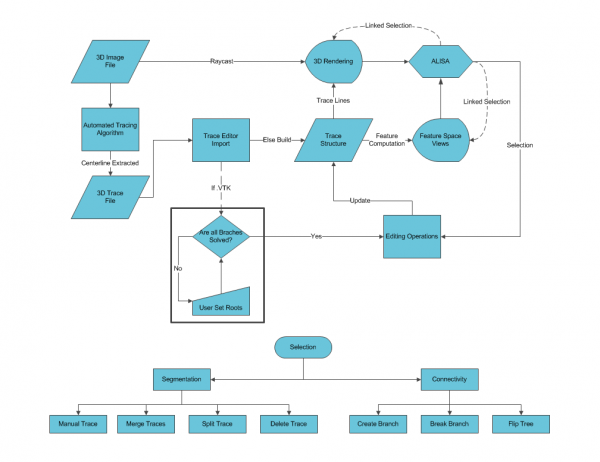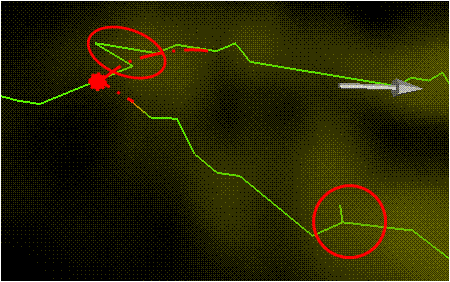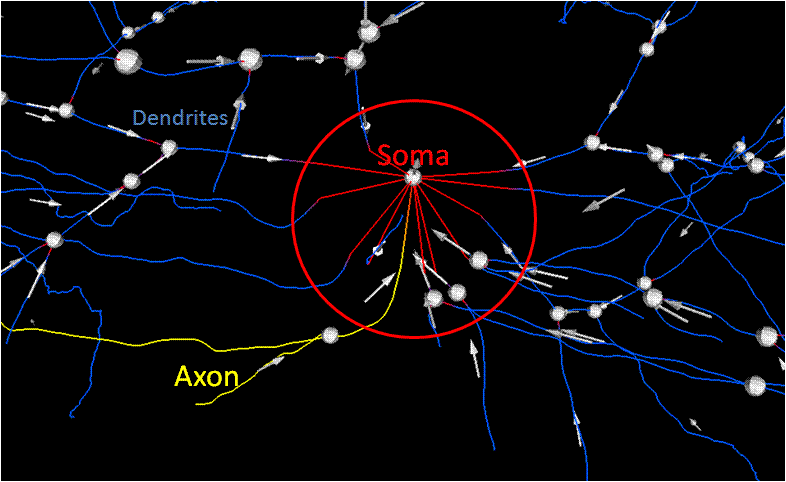Trace Editor/Features
Contents |
Trace Structure
To handle all of the traces the editor uses a tree structure. Neuron branching can be represented as series of points with parents and children. The Inputs Traces to the trace editor can be either SWC, or RPIXML format.
Notes: Branch point is a Bifurcation, only the Soma should have more than two children. The traces are divergent from the root of the tree (or the Soma if present).
RPI XML
The RPIXML format can be extended to read in extra computed features, that may be specific to a data type or algorithm, by including a header with the features to search for.
<FeatureHeaderNames> HeadSize,SpineLength,SpineSize,HeadToLengthRatio,DistanceToDendrite,Intensity </FeatureHeaderNames>
Defining the Features to compute in the XML file. The XML file reader will find all traces with associated features which will show in the linked space views.
<TraceLine ID="1" Type="1" Parent="-1"> <TraceBit ID="1" X="0.81" Y="255.81" Z="50.55"/> </TraceLine> <!--Dendrite ID=1-->
TraceLine 1 is a dendrite (type 1), consisting of 1 trace bit, and has no parent (indicated by the -1). There are no extra features calculated for this trace.
<TraceLine ID="2" Type="5" Parent="1" HeadSize="0.000" SpineLength="7.828" SpineSize="14.000" HeadToLengthRatio="0.000" DistanceToDendrite="1.178" Intensity="146.856"> <TraceBit ID="1" X="4.00" Y="255.00" Z="50.00"/> <TraceBit ID="5" X="3.00" Y="254.00" Z="49.00"/> <TraceBit ID="9" X="2.00" Y="254.00" Z="49.00"/> <TraceBit ID="13" X="2.00" Y="253.00" Z="48.00"/> <TraceBit ID="17" X="2.00" Y="253.00" Z="47.00"/> <TraceBit ID="21" X="2.00" Y="253.00" Z="47.00"/> </TraceLine> <!--Ending Spine ID=2-->
TraceLine 2 is a spine (type 5), consisting of 6 trace bits, and has a parent TraceLine 1. There are 6 extra features computed and are defined in the Feature Header Names.
The Trace object is built from organizational objects provided to compute and organize features on several levels.
- Trace Object
- Trace Line (id, type, parent id, <Trace Bits>)
- Trace Bit (id, x, y, z, r)
- Trace Gap (Trace Line 1, Trace Line 2)
- Branch Point (Trace Bit, <Trace Lines>)
- Trace Line (id, type, parent id, <Trace Bits>)
Trace Bit
The Trace Bit is the basic unit of the trace structure as a point in 3d space (x,y,z).
Each bit also stores the radius and an ID.
Trace Line
Trace Lines are single trace segments between two critical points that contain an ordered list of trace bits.
Each Trace Line has a unique ID.
Each stores a pointer to any parents or children(branches).
Trace Lines have a type (Soma, dendrite...) that defines its properties.
Trace Object
The Trace Object is a container of all the traces.
This is responsible for creating the VTK structure, functions modifying the tree structure, and handling file input/output.
Branch Point
The Branch object is a convenience structure included to help solve branching order problems when the tracer does not know the Proximal/Distal points or the Soma.
The data is a Trace Bit and a vector of three or more Trace Lines.
Use the set roots command to solve the parent child relationships in the graph structure.
Trace Gap
A trace gap is an object representing an associative measurement between the smallest separation of the endpoints of two trace Lines.
This is used in merging to reconnect fragmented traces.
Features and algorithms for Trace Editor
The Trace Editor uses several intrinsic and computed features in both manual and automated processes.
Most features used for editing operate on the trace lines or the gaps.
For specific neural structures such as dendritic spines further features may be computed.
Intrinsic Features
- Trace ID:
- The ID is a unique number to look up each trace
- Radius:
- Average Radius of the Trace
- Type:
- The type of neural structure it is
- Parent:
- The ID of the previous Trace in the tree, -1 if it is a root
- Root ID:
- The ID of the first trace of each tree
- Level:
- Following the shortest path of branching how many traces in the tree to reach the root.
- Number of Children
- If it branches how many children if it is not a soma should be 0 or 2
- Is Leaf
- Value is 1 if Trace is a terminal tip
Computed Features and Calculation Parameters
| Feature | Description | Equation or Variable |
|---|---|---|
| # of Bits | How Many points in the Trace | n |
| Path Length | Total length along a trace, indicated by the size of the trace | 
|
| Euclidean Length | Straight line distance between the endpoints of a trace | 
|
| Tortuousness | Also known as Fragmentation Smoothness or Contraction. Ratio of Path Length to Euclidean Distance [1] | 
|
| Trace Density | The Average Spacing of Trace Bits | 
|
| Volume | Volume is calculated by the local radius and path length | 
|
| Distance to parent | Separation of child traces to the parent | 
|
| Path to Root | Full path length to root | 
|
| Merging Specific Features | ||
| Gap Size | Minimum distance between endpoints of two traces | 
|
| Angle | The angle created between two traces normalized as vectors | 
|
| Maximum Gap Distance | The maximum distance between endpoints that can be merged | Δ |
| Weights | The weights are used in the cost1 algorithm | α β |
| Cost1 | Weighted scalar evaluating the merge [2] | 
|
| Cost2 | Weighted scalar with Fragmentation Smoothness | ![C_2=\theta[\frac{d}{\Delta}]s](/mw/images/math/8/3/8/838dc6bcf55d56903864da4855c33cca.png)
|
| Curvature | The Hessian matrix for checking branching point existence and interpolating the path. | ![\left[\begin{array}{ccc}
f(x)_{xx}(X) + \frac{\alpha}{2}f_{yy}(X) + \frac{\alpha}{2}f_{zz}(X) & (1-\alpha)f_{xy}(X) & (1-\alpha)f_{xz}(X) \\
(1-\alpha)f_{xy}(X) & f_{yy}(X) + \frac{\alpha}{2}f(x)_{xx}(X) +\frac{\alpha}{2}f_{zz}(X) & (1-\alpha)f_{yz}(X) \\
(1-\alpha)f_{xz}(X) & (1-\alpha)f_{yz}(X) & f_{zz}(X) + \frac{\alpha}{2}f(x)_{xx}(X) +\frac{\alpha}{2}f_{yy}(X)
\end{array} \right]](/mw/images/math/8/6/2/86265c277f698370dbb9b8bbf95c9619.png)
|
Cell Features
- Segments
- Total number of Traces in the Tree
- Stems
- Number of Processes attached to Soma
- Branch Pt
- How many branches in the cell
- Leaf Nodes
- Total number of terminal tips
- Leaf Level
- Number of compartments in the cells
- Leaf Path Length
- Terminal path length
- Total Euclidean Length
- Sum of all compartment euclidean lengths
- Total Path Length
- Sum of all compartment path lengths
- Average Segment path length
- Average path lengths of the compartments
- Total Volume
- Sum of Volume of each compartment
We are currently working on integrating further with L-Measurefor a more detailed cell analysis.
Algorithms
Merge Small Gaps
Goal: Create longest continuous trace segments by merging close endpoints Methods: Nearest neighbors (Closest end points),
Rejection based on conflicts and thresholds
- Minimal distance between end points
- Angle between traces The angle is measured between the two traces by computing the norm of their vectors and the dot product.
The equation is: which when solved for θ is:
which when solved for θ is: 
- Path length The path length is considered if the end points are not the best fit for the merge. For instance, a merging that would cause a sharp peak in the neurite. This is a more serious problem for large gaps (see below). To help alleviate this for small gaps, merge at the point where the direction changes sharply.
- Gap distance is too large The distance between the two points e_1, e_2 is computed to save computation. If the distance is longer than the excepted small gap distance, then the traces will not be considered for merging. A cost function adapted from "Automated Three-Dimensional Tracing of Neurons in Confocal and Brightfield Images" will take into account small gaps with two end points.
- Consider possibility of loops Though less probable in 3D, often there are 2D projections of 3D images resulting in loops being in the images. Loops in the branching structure can be avoided by checking the parents, Each of the trace Lines should have unique root nodes.
- Angle between traces The angle is measured between the two traces by computing the norm of their vectors and the dot product.
- Another trace is a better fit (Cost Function)
- Smallest gap
- Better Angular alignment
- "Bad merge"
- The merge causes corners
- Needs to be smoothed

The Cost function we have implemented is modified from:

to include fragmentation smoothness. The original function had user selectable weights α,β to scale the effects of the gap distance and angle of the merge. The Fragmentation smoothness is the ratio of the path distance to the end point displacement. If the merged traces start forming a "U" shape or a loop it would result in a higher cost. A second alteration is to multiply the factors so that the outliers are further differentiated from the more probable traces. The resulting formula:
![C_2=\theta[\frac{d}{\Delta}]s](/mw/images/math/8/3/8/838dc6bcf55d56903864da4855c33cca.png)
accounts for the three factors of angle, gap distance, and smoothness of the trace.
Interpolate Large Gaps
Goal: Connect Large gaps that step 1 cannot simply connect by addition of a single cell Method: Larger gaps need new segments created,
new Trace Bits must be added using manual tracing in the 3D cursor toolbox
Branch Points
Goal: Detect and control Branching Method: Detect most probable intercepts,
Determination of main branch and child,
Type of branch point
- Distance maps
- Nearest neighbors (traces)
- Closest trace bits
- Angle of intercept
- Interpolation
Detect most probable intercepts: So far most of the methods I have evaluated or developed require information about the intensities in order to compute the most probable intercept. The reasoning behind this is the direction of the child branch does not give information about the intercept over long distances. In the short distance branching case, it is more acceptable to use the direction to figure out the interception point. The child branch would have to curve faster( over a shorter distance) if the direction of the branch was not in line with the main branch. In the case of a large gap between the main and child branch the child can curve slowly and still reach the main branch. This means that when there is a large gap there is more variation in the location of the intersection. So, to determine the proper intersection we can use the H(x) matrix listed in the features. I think when the gap is small( not sure what this is yet) we can just fill with a shortest distance line.
Soma Detection
Goal: Correspond processes with a soma Method: Segmentation of original data,
Localize the area to attach processes to soma,
Correct direction of traces
- Image intensity
- Blob segmentation
- Centroid
- Distance map
- Connectivity
- Connected components
- Localization of processes
Fragments
Goal: Removal of small traces that do not correspond to a process Method: Small traces removed,
Leftovers from splitting operators,
Line fragments that cannot be merged
- Lowest percentile of length
- Traces with no parents or children
- Type dependent


